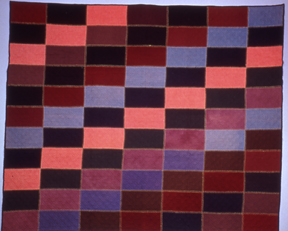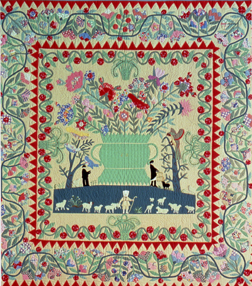

| For more information about this article or gallery, please call the gallery phone number listed in the last line of the article, "For more info..." |
August Issue 2003
Mint Museum of Craft + Design in Charlotte, NC, Features Major Quilt Exhibition
Fleur Bresler learned her lessons well. As a volunteer docent for the Division of Social History at the Smithsonian Institution's National Museum of American History, she -came under the wing of quilt scholar Doris Bowman, Curator of the Textiles Collection. Researching the printed chintzes, all-white quilts, glazed wool quilts and indigo resist fabrics in the Smithsonian collection introduced Fleur to the writings of textile and quilt historians Barbara Brackman, Florence Montgomery, Florence Pettit and Patsy Orlofsky.
"That was my education and the impetus for my quilt collecting," stated Bresler. "It opened my eyes to the possibility of creating a small, representative group of quilts with historical significance."
The result of a 20 year pursuit of her goal will be on display in the exhibition American Quilt Classics 1800 - 1980: The Charles and Fleur Bresler Collection at Charlotte, NC's Mint Museum of Craft + Design (MMC+D) Aug. 30 through Jan. 4, 2004. The exhibition presents a comprehensive visual primer to American quilt history.
"What Fleur Bresler achieved in building her focused collection is nothing short of amazing," stated MMC+D Curator Melissa Post. "The 37 quilts donated to the Mint and on display represent all but two of the known quilting styles throughout the history of American quilting. Even more impressive, very few gifts or collections come to a museum with the extent of research, provenance, condition reports and correspondence history that came with the Bresler Collection."
 Bricks
Quilt
Bricks
Quilt
American Quilts Classics features white work, indigo resist and block-printed chintz from the late 18th and early 19th centuries; appliqué, stenciled, mosaic template-pieced and album quilts from the mid 1800s; log cabin, crazy and charm quilts from the late 19th century and a group of 20th century Amish pieced quilts. Ten of the thirty-seven quilts are smaller-sized quilts (doll, crib or child). Crib quilts are especially prized since few survived.
"The American quilt has been called the quintessential metaphor for the American experience," wrote quilt historian Merikay Waldvogel in the exhibition catalogue. "Layered, stitched, embellished and reworked, quilts reflect the cultural, aesthetic and artistic heritage of this country. Quilts have never been simple, utilitarian bedcovers. Too much time and imagination go into making a quilt for its purpose to overshadow its creative form."
Quilted bed covering and needlework traditions arrived in America with the first colonists. Each wave of immigrants would add to the development of the American Quilt along with new technologies for printing brighter fabrics at lower prices. By the mid 1800s, an American style had emerged distinct from British and European influences. Earlier quilt designs were revived and reworked while new patterns and layouts using contemporary fabrics and color schemes emerged. The Hexagon Mosaic quilt of 1830 became Grandmother's Flower Garden by 1930, while the Victorian Era crazy quilt became the Depression Era Scrap quilt.
"The structure and design of a quilt allows for innovation and experimentation," stated Waldvogel. "It is not unusual for a quilt to include several styles and techniques as well as stenciling, painting, embroidery or even beading."
During the Colonial Era, English textile manufacturers enjoyed a protected market in America. Chintz fabrics imported from India were popular in making whole cloth quilts. The Pillar Printed Chintz Quilt, c.1830 on display in the exhibition was likely made for a four-poster bed with matching canopy and bed hangings. In contrast, the Mosaic Quilt from the same time period, was made from thousands of tiny pieces of cloth cut from print and solid fabrics with a dazzling finished effect reminiscent of a mosaic tile display.
Appliqué quilts (fabric designs cut from colored cloth sewed or applied to a contrasting background fabric) were prevalent by the early 19th century. By mid 19th century, appliqué quilts with their sophisticated designs and precise needlework were highly prized. When given to brides, newborns and departing friends, they often contained names and dates, embroidered, inked or quilted onto the surface. The crib-size Medallion Quilt from the Bresler Collection is centered with one Pierced Rose block and contains the signature and date, "Grandmother, 1861."
 Baltimore
Album Quilt
Baltimore
Album Quilt
Album quilts appeared in the 1840s at the same time autograph collecting came into fashion. Non-corrosive ink allowed the inscription of sentimental messages, leaving written legacies on the quilts. Used as presentation pieces in honor of a friend's wedding, a minister's good works or a child's birth, album quilts were usually coordinated by one person with others contributing and signing the blocks. Baltimore Album Quilts are regarded as the epitome of mid 19th century quilts for their techniques, fabrics and pictorial images that may include Baltimore monuments, buildings, war heroes or prominent citizens. One of the most important of the Bresler Collection quilts is the Baltimore Album Quilt, c. 1852, made by Catherine Bell Hooper that was documented in Dr. William Dunton's seminal book Old Quilts in 1946.
By 1860 American styles had eclipsed British medallion and mosaic quilts using multiple blocks of equal size for both pieced and appliquéd quilts. Any geometric design was possible for pieced blocks.
The invention of the sewing machine and mass distribution of magazines such as Hearth and Home, featuring a monthly quilt pattern submitted by readers, inspired a quilting revival by the end of the 19th century. The Charm Quilt, in which no two patches in the quilt are cut from the same fabric, originated in the 1870s as low-cost calico prints became plentiful following the Civil War. Magazine readers would exchange the thousands of patches needed for one quilt through the mail. Even with a later revival in the 1930s, Charm Quilts remain a quilt that one does but once. The Bresler Collection Charm Quilt made by Ruthie Stubbs in 1880 features a wide variety of late 19th century prints including rust-colored madder prints, black-and-white mourning prints, conversation prints and Turkey Red calicos.
Log Cabin quilts and Crazy quilts both called for a foundation of waste cloth that was covered by odd shapes or strips of cloth. Victorian Crazy quilts became known as America's first art quilts, made of pieces of silk and velvet, embellished with embroidered birds, flowers and stars. The Bresler Collection Victorian Crazy Quilt contains many typical motifs - fans, interlocking circles, owls, a butterfly, a trumpet lily and a small girl feeding a duck.
In 1911, Marie Webster, an inventive Marion, Indiana quilter, provided a modern look for American quilts with softer colors and naturalistic designs popularized by the Ladies Home Journal. Webster also revived the center medallion format and the elaborate quilting of the early 1800s by creating designs that harmonized with the Arts and Craft style of the early 1900s.
Quilt making surged in popularity during the Great Depression as much as a relief to the economic hard times. Manufacturers, hoping to jump start the ailing retail market, provided light, bright and cheery fabrics. The Postage Stamp Quilt on display in American Quilt Classics contains thousands of tiny pieces of cloth popular in the 1930s.
 Warner
Quilt
Warner
Quilt
The most unusual and mystifying quilt in the Bresler Collection, constructed in the 1930s, is the Phoebe Warner Quilt which surfaced in Connecticut with minimal information about its provenance. Antique quilt dealer Stella Rubin, acting on behalf of Fleur Bresler, recognized it at auction as a close copy of the famous 1803 appliqué quilt made by Sarah Warner Williams of New York City for her cousin Phoebe Warner that is a prize of the Metropolitan Museum of Art. In place of the initials "PW" on the urn on the original quilt, the unknown quiltmaker embroidered the initials "EK", possibly her own.
While quilting declined significantly during World War II and the post war years, strikingly modem designs continued to be made by Amish quilters. The Amish Diamond in a Square, C. 1928, on display is classic Lancaster, Pennsylvania quilt design. Quiltmaking rebounded again following the popular and critical reaction to the 1971 Whitney Museum of American Art exhibition Abstract Design in American Quilts. Quilts gained in appreciation in their new-found cultural context. Contemporary quilt design flourishes with new technology employed (designing on a computer), new materials explored and more artists using the medium as a vehicle for expression.
For more info check our NC Institutional Gallery listings, call 704/337-2000, or on the web at (www.mintmuseum.org).
Carolina Arts is published monthly by Shoestring Publishing
Company, a subsidiary of PSMG, Inc.
Copyright© 2003 by PSMG, Inc., which published Charleston
Arts from July 1987 - Dec. 1994 and South Carolina Arts
from Jan. 1995 - Dec. 1996. It also publishes Carolina Arts
Online, Copyright© 2003 by PSMG, Inc. All rights reserved
by PSMG, Inc. or by the authors of articles. Reproduction or use
without written permission is strictly prohibited. Carolina
Arts is available throughout North & South Carolina.